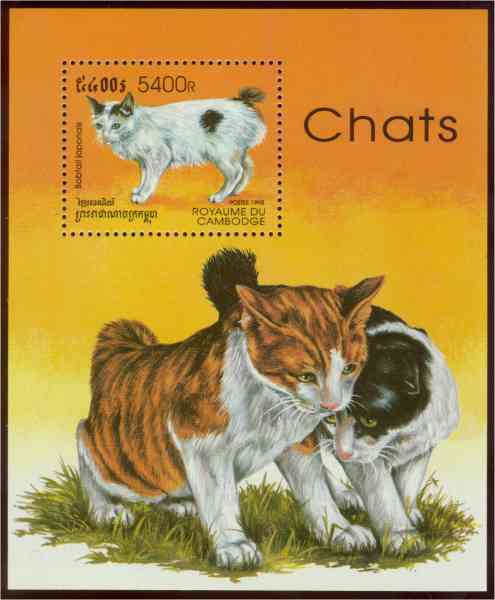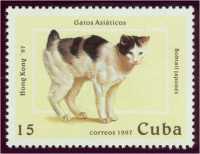Cambodia
1998


Even though it is known by an English name, the Japanese Bobtail ("Neko" in Japanese) is really an ancient breed. Manuscripts, paintings, and other art give evidence that it has existed in Japan for at least 1,000 years. Legend says that this breed originated when a cat was sleeping near a hearth and a spark flew out, igniting its tail. The cat sped through the streets of the Imperial City, setting all the houses on fire as it ran. The city was destroyed and the emperor was furious. In his anger, he decreed that all cats must have their tails cut short; thus the Bobtail came into being.
There are sketches of Bobtails in ancient ruins and documents, sitting next to geishas. In seventeenth-century Tokyo the walls were decorated with paintings of one of these cats, named "Maneki Neko," which means Welcoming Cat. They used to say it brought good luck. Many Japanese and Chinese shops in North America display a small statue or piggy bank of Maneki Neko next to their cash register.
For centuries the Bobtails were the exclusive pets of the nobility, who used to walk them on a collar and lead, but in the beginning of the 17th century it was decreed that all the noble cats had to be set free to act as badly needed pest-controllers. From that point onwards it became known as the "Kazoku Neko," the Family Cat of Japan.
An additional factor that may help to account for the popularity of this short-tailed cat is the existence of a folk myth in Japan which warns that long-tailed cats can change into human form and bewitch their owners. Japanese Bobtails are distinguished by their short curled tails, a trait that is unique to the breed but differs on each individual. The hair on the tail is longer than the hair on the body. This extra length gives the tail its characteristic pompom or bobtail look. Incidentally, the gene responsible for the Bobtail is not related to the Manx gene.
These distinctive cats have high cheek bones, large, high-set ears, and large eyes that are set into the skull at a rather pronounced slant. The set of the eyes gives the breed its distinctive look when compared to other Oriental breeds.
Japanese Bobtails are very affectionate, intelligent, and enjoy a lot of play. They require little grooming and shed very little, making them particularly attractive to owners who find shedding a problem. Bobtails express themselves well with their body language and have soft voices capable of a broad range of tones. Some people say they sing! Since they adore human companionship, they almost always speak when spoken to. They like to carry things in their mouths, and most enjoy a good game of fetch. Masters of the pounce, these cats love to ride on shoulders. They are good travelers. They donít panic at shows or strange hotel rooms, they adjust to dogs and other animals, and they are especially good with children.

|
| Previous Page | Home | Next Page |